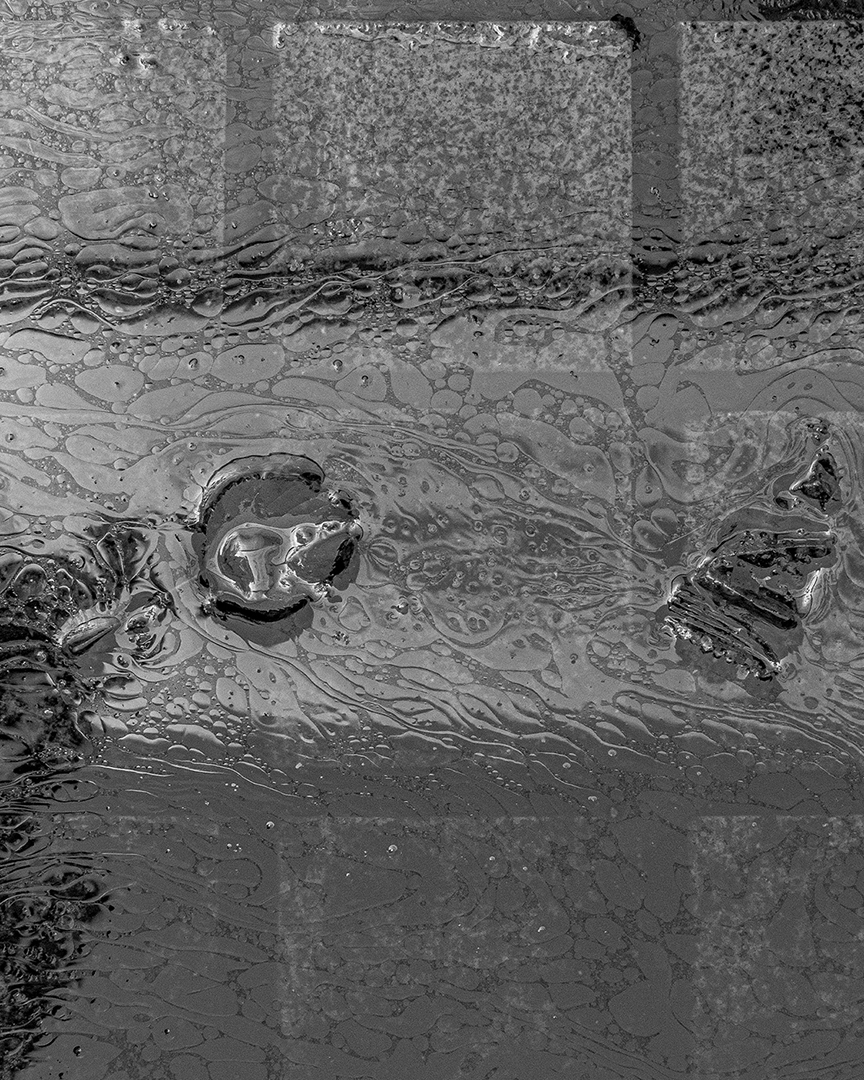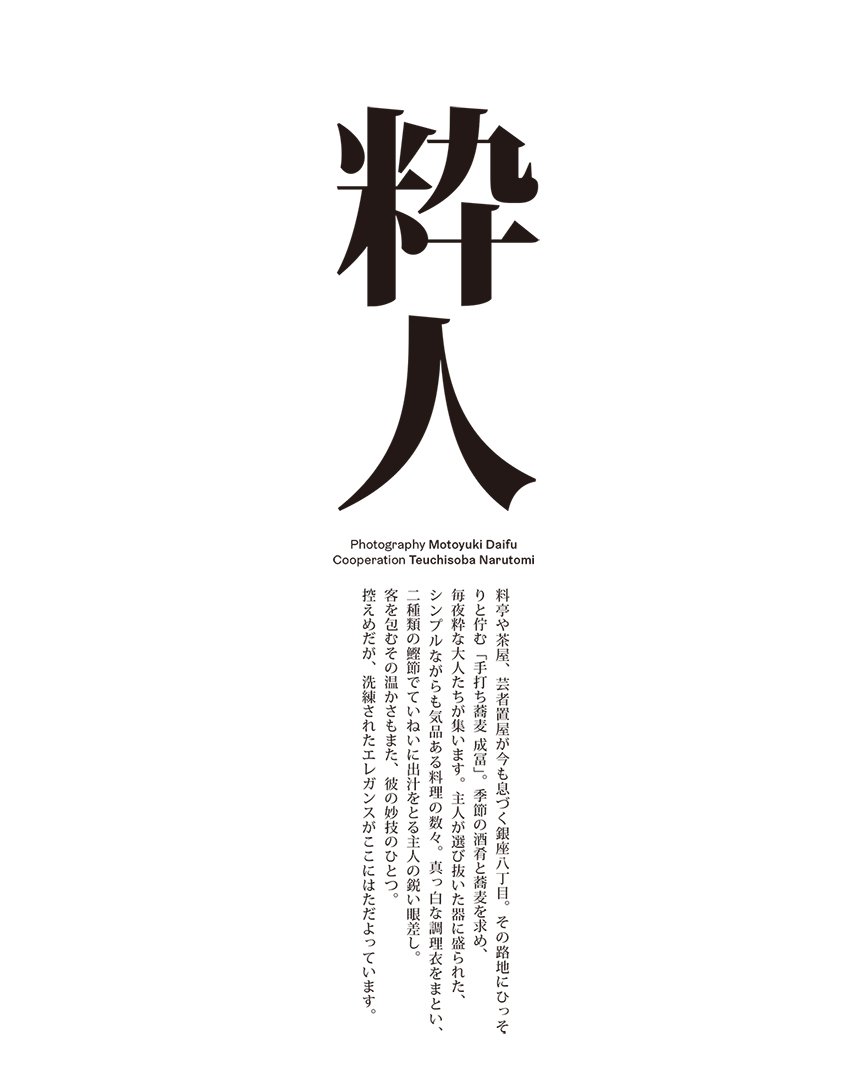
銀座――この魅力的な街は、多くの人々にとって、特別な瞬間や記憶に残る場所となっています。親に手を引かれて足を踏み入れたデパート、マスターのこだわりを感じる喫茶店、初デートで訪れたレストラン。どれもが、この街の独特の雰囲気と結びついています。
連載「銀座・メモワール」では、森岡書店代表、森岡督行さんがナビゲーターとして登場します。多様なゲストが織りなす銀座の豊かな物語を共有し、銀座の多面性とその普遍的な魅力に焦点を当てます。連載を通じて、銀座の隠れた魅力と多彩なストーリーに触れ、新たな価値を一緒に発見しましょう。
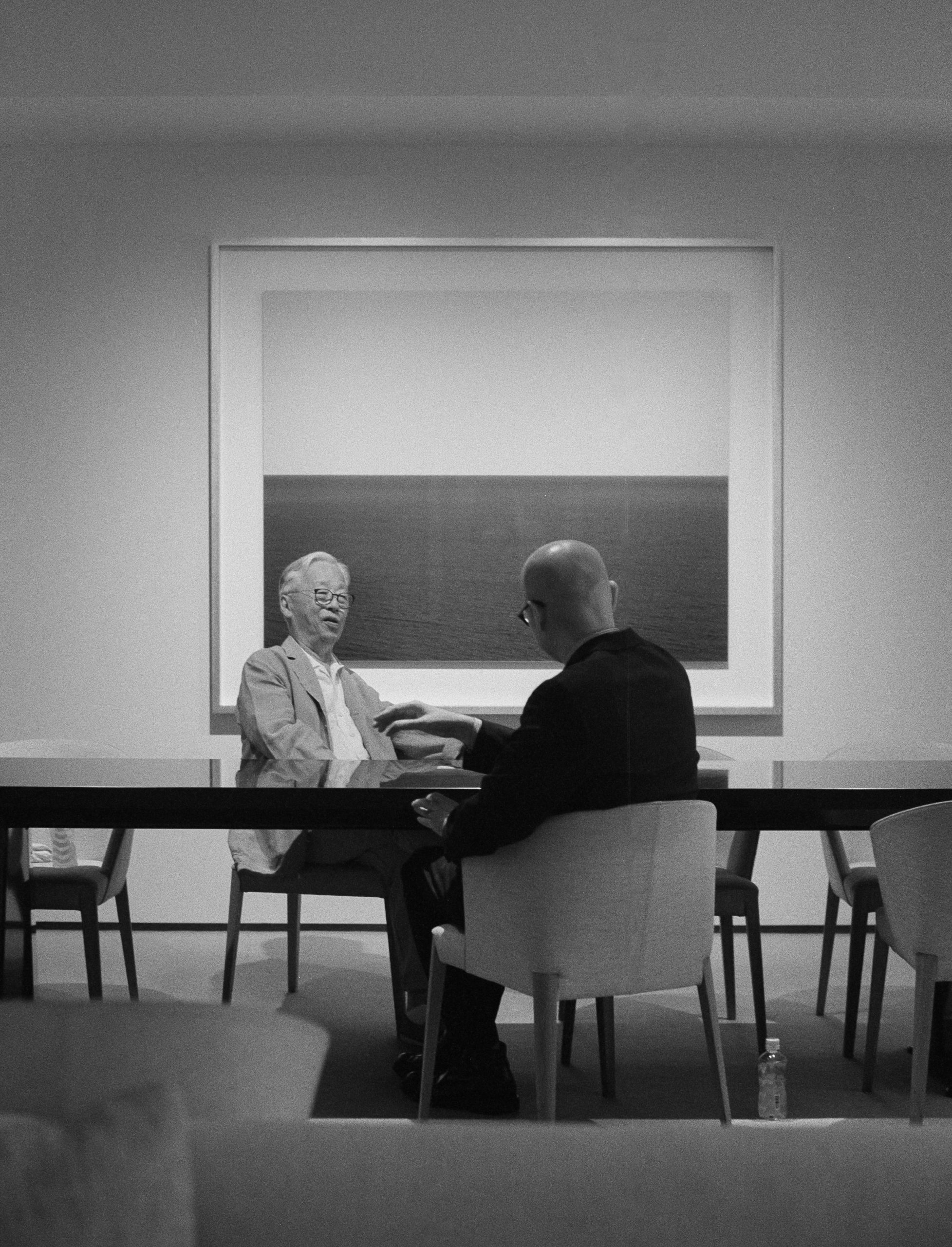
杉本博司さんを初回のゲストに迎えた連載「銀座・メモワール」。前篇では、戦前のモダニズム建築やPX時代の銀座、杉本さんが初デートで訪れたイタリー亭にまつわる記憶を辿りました。後篇は、老舗キャバレーでの貸切りパーティや、今はなき映画館の思い出に続きます。
大学時代に制作された、幻の広告ポスター
森岡 杉本さんは銀座で作品を発表される機会が多いですよね。
杉本 銀座というか小柳でね。でも大学の頃に学生広告コンクールで優勝して、東芝画廊というギャラリーで展覧会をしたことがありました。7丁目のビルの上層階にあったんですよ。
森岡 広告を作られていたんですか?
杉本 立教で広告研究会に入っていたんですよ。一口に研究会といっても、部員が百何十人もいましたから二派に分かれていました。ひとつは海の家を開いたりする遊び人の集まり。もうひとつは、生産様式において広告が占める位置づけを問うような、社会科学として広告を研究するグループ。僕は両方、遊び人もやりながらマルクスの唯物史観もやっていました。
森岡 面白いですね。じゃあ、それが杉本さんにとって最初の展覧会になるわけですか。
杉本 学生の作品ですけどね。でも、このあいだ倉庫から出てきた受賞作を久しぶりに見直したのですが、今見てもおしゃれですよ。これは西武の広告を想定して制作したイヴ・サンローランとマリー・クヮントのポスター(といってスマホの画面を見せる)。写真を素材として使って、モデルの手や身体の一部をディストーションしています。我ながら、なかなかセンスが良い。コマーシャルのデザイナーでも食っていけたんじゃないかな(笑)。この広告は、僕がロサンゼルスのアート・センター・カレッジ・オブ・デザインに入学するときの、ポートフォリオでもありました。
森岡 小学生のときにも、絵画コンクールで入賞されていたんですよね。
杉本 小学校5年生のときですね。松坂屋の屋上から和光方面を見た風景を描いた絵が入賞しました。その絵は入選作の展覧会として東南アジアを巡回したんですけど……結局返ってこなかったですね。


「白いばら」での貸切りパーティー
森岡 松坂屋の跡地に建ったGINZA SIXの会員専用ラウンジは杉本さんの設計です。銀座にはずっとご縁があるんですね。
杉本 フランス芸術文化勲章オフィシエをいただいたときは、「白いばら」で祝賀パーティーを開いたこともあります。元々通っていたわけではないんだけど、日本で何かやろうというので、貸切りにしてフランス大使を招きました。
森岡 私も何度か行ったことがあります。店の外壁に日本地図が飾られていて、各都道府県出身のホステスさんを指名できることで有名な老舗キャバレーですよね。2018年に閉店してしまいましたが。
杉本 ショータイムがあって、カーニバルみたいな出し物も見られた。カップルや夫婦で来る人たちもいましたよ。店内にバンドがいて、歌いたい曲をリクエストすると伴奏してくれたり。まあ、歌っても誰も聴いてないですけどね(笑)。
森岡 何を歌われたんですか?
杉本 祝賀パーティーのときはエディット・ピアフの「愛の讃歌」。「朝日のあたる家」も浅川マキの日本語訳詞で歌いました。(「♪あた〜しが〜着いた〜のは〜」とちあきなおみ風に歌い出す。)
森岡 私は山形出身なんですけど、茨城出身のかたがついてくださって。ずいぶん遠いんですけど、わからないでもないなという。そんな思い出があります。
杉本 ホステスのかたはショー劇団の団員だったりするので、みんな歌が上手いんですよ。ぽっきり1万円、明朗会計でしたね。銀座の文化もどんどん変わってきていますが、昔から7丁目や8丁目は華やかな世界でした。僕はあまり付き合いがありませんでしたが、「銀巴里」だけはよく行きましたね。
森岡 美輪明宏さんも歌っていたという日本初のシャンソニエですよね。
杉本 ええ、美輪明宏さんが歌っているのも見ましたよ。1968年くらいですか。「別れのサンバ」を歌ってた長谷川きよしも見ました。

映画館通いとマカロニグラタン
森岡 先ほどお母様と映画館に来られていたというお話がありましたが、学生時代はどうでしたか。
杉本 銀座の映画館にはよく行きましたよ。テアトル東京とか。
森岡 今コナミクリエイティブセンターが建っている場所ですね。
杉本 セットバックして、前に噴水があってね。すばらしい建物でしたよ。
森岡 観た映画の記憶はありますか。
杉本 『偉大な生涯の物語』とか『ベン・ハー』はテアトルで観ましたね。それから建て替え前の東劇(東京劇場)。あれも良い映画館でした。
森岡 写真を見るかぎり、東京を代表するような美しい建物です。
杉本 出光美術館になる前の帝劇(帝国劇場)では、シネラマ第1作の『これがシネラマだ』を観ました。世界中の名所を巡るアトラクションのような映像で、すごかったですよ。あの建物も壊しちゃって、もったいないなあと思いますね。
森岡 私がかろうじて知ってるのは並木座です。三木ビルという建物自体は今でも残っていて、このあいだ見に行きました。外壁は改装されていますけど、なかは今でも当時の仕様が残っています。
杉本 並木座もありましたね。高校・大学の頃は親とは関係なく、みゆき座とかフランス映画がかかっている名画座に観に通いました。
森岡 喫茶店や甘味処はどうでしたか。
杉本 子どもの頃は不二家でしたね。資生堂パーラーはお高くとまっていて……いや冗談(笑)。資生堂パーラーは大人になってから行くようになりましたけど、子どもの頃は不二家でした。マカロニグラタンとか、美味しかったですね。
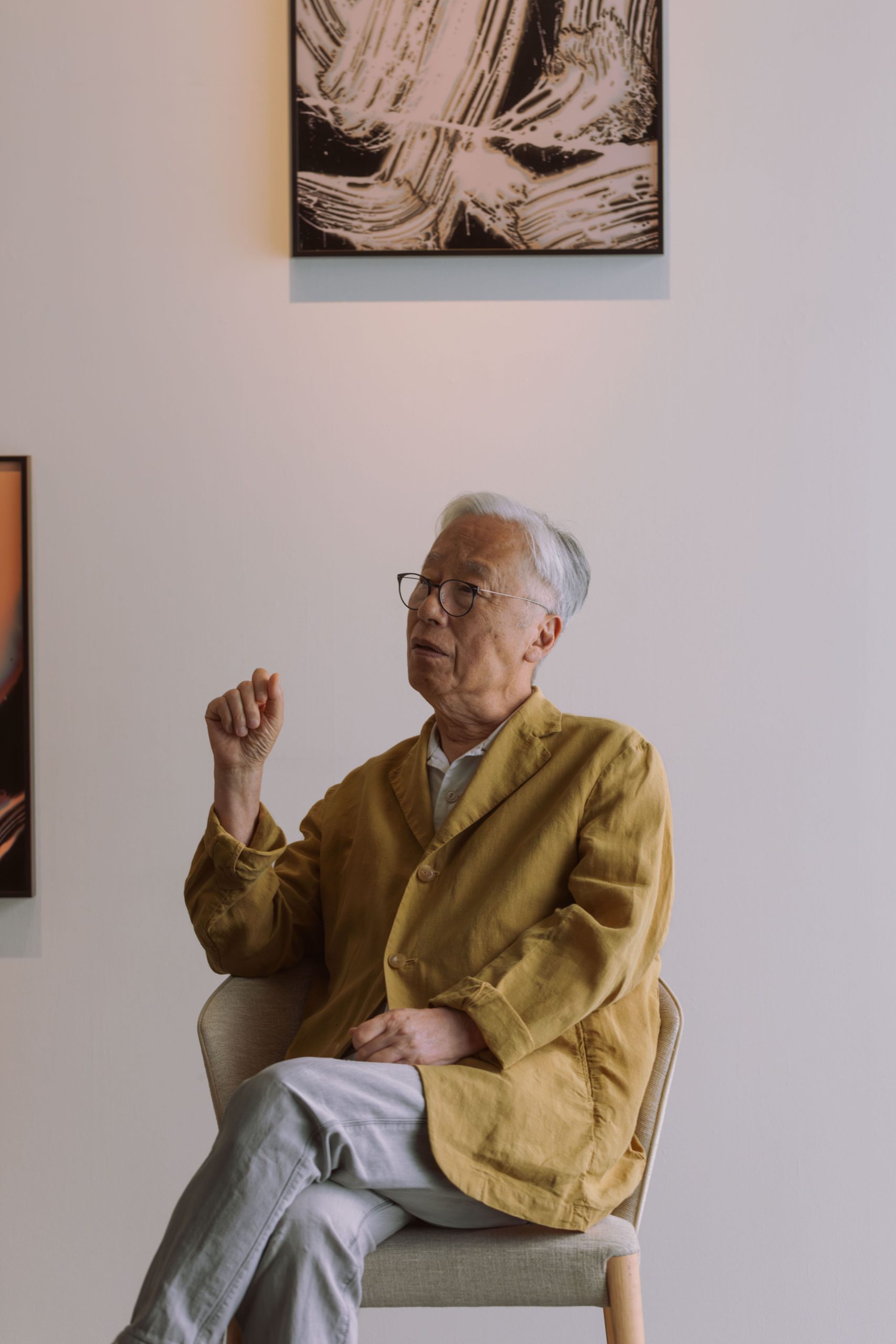
これからの銀座のために
森岡 杉本さんから見て、銀座はどう変わってきたと思われますか。
杉本 銀座一帯にはかつて、甘味やなど木造一軒家の個人店がたくさんありました。それが建て替えに次ぐ建て替えによって、今ではビルばかりになっている。それから建物の高さ制限も緩和されて、ビルの高層化や建て替えが進んでいますね。銀座の姿が関東大震災で一変し、戦争で焼け落ちてまた大きく様変わりしたことを思えば、そうした変化は歴史上逃れがたく起こるものなのでしょう。でも、せいぜい3階分の高さのためにビルを建て替えるのは、資源の無駄遣いだと思うんですけどね。
森岡 関わる人の想いが深い分だけ、銀座の建物はさまざまなかたちになっていくということでしょう。
杉本 建築でいえば、大工の腕や建築家の趣味でもって建てるということがなくなってしまったんですよ。「安い・早い・旨い」の牛丼家方式で作ろうとするから、シンガポールに行ってもマンハッタンに行っても、同じようなビルばかりになる。旧帝国ホテルみたいなものを建てるなんて今では不可能に近い。それでは街並みも面白くならないですよ。とはいえ、僕は建築の仕事もありますので、微力ながら、自分のできる範囲はしっかりやらせてもらおうと思っていますけどね。
森岡 今後、銀座が銀座として輝き続けるには何が必要だと思われますか。
杉本 60年代後半の学生運動で投石騒ぎになって、柳が切られてしまったのが悲しかったですね。「昔恋しい 銀座の柳」という歌もありますが、やはり柳は復活するべきだと思います。銀座のシンボルですから。
森岡 石といえば、GINZA SIXのラウンジで都電の敷石を素材として使っていらっしゃいますよね。
杉本 あれは京都の旧市電に使われていた敷石。廃線になったときに、すべて民間に払い下げたので、探せば今でも手に入るんですよ。都電にも敷石があったはずだけど、どこに行っちゃったんでしょうね。
森岡 最後のひとつ。杉本さんにとって、銀座はどんな街ですか?
杉本 どういう街か……日本中にある銀座商店街の総元締かな(笑)。
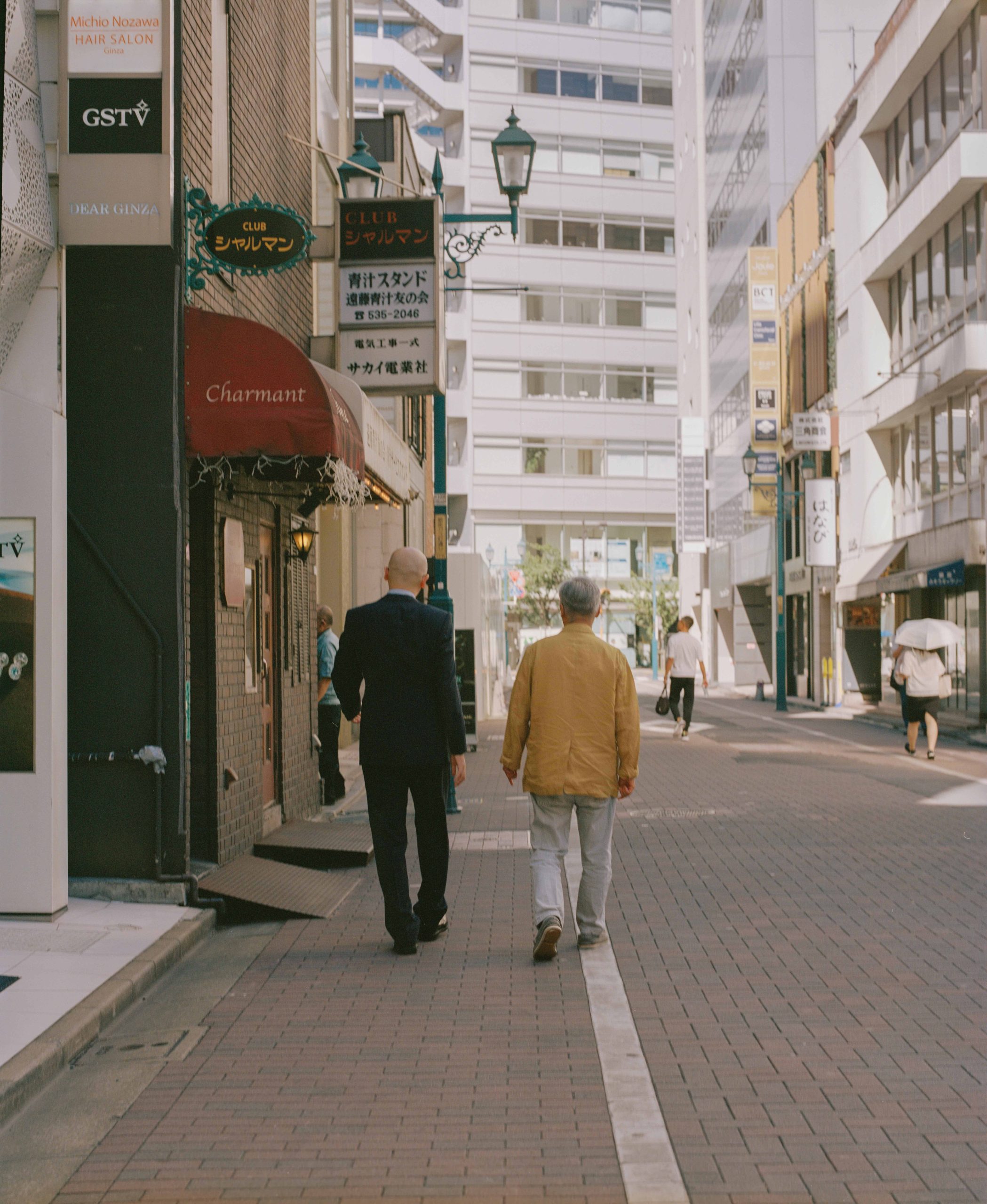
杉本博司
杉本博司の活動分野は、写真、彫刻、インスタレーション、演劇、建築、造園、執筆、料理、と多岐に渡る。杉本のアートは歴史と存在の一過性をテーマとしている。そこには経験主義と形而上学の知見を持って、西洋と東洋との狭間に観念の橋渡しをしようとする意図がある。時間の性質、人間の知覚、意識の起源、といったテーマがそこでは探求される。1948年 東京、御徒町に生まれる。1970年渡米、1974年よりニューヨーク在住、2008年建築設計事務所「新素材研究所」設立。2009年公益財団法人小田原文化財団設立。
受賞:1988年 毎日芸術賞、2001年 ハッセルブラッド国際写真賞、2009年 高松宮殿下記念世界文化賞(絵画部門)、2010年 秋の紫綬褒章、2013年 フランス芸術文化勲章オフィシエ賞、2017年文化功労者。2023年日本芸術院会員に選出。
主な著書:『苔のむすまで』『現な像』『アートの起源』『杉本博司自伝 影老日記』(新潮社)、『空間感』(マガジンハウス)、『趣味と芸術』(ハースト婦人画報社)、『江之浦奇譚』(岩波書店)など森岡督行
1974年山形県生まれ。森岡書店代表。文筆家。『800日間銀座一周』(文春文庫)、『ショートケーキを許す』(雷鳥社)など著書多数。
キュレーターとしても活動し、聖心女子大学と共同した展示シリーズの第二期となる「子どもと放射線」を、2023年10月30日から2024年4月22日まで開催する。
https://www.instagram.com/moriokashoten/?hl=ja平岩壮悟
編集者/ライター
1990年、岐阜県高山市生まれ。フリーランス編集/ライターとして文芸誌、カルチャー誌、ファッション誌に寄稿するほか、オクテイヴィア・E・バトラー『血を分けた子ども』(藤井光訳、河出書房新社)をはじめとした書籍の企画・編集に携わる。訳書にヴァージル・アブロー『ダイアローグ』(アダチプレス)。
https://www.instagram.com/sogohiraiwa/ナタリー・カンタクシーノ
フォトグラファー
スウェーデン・ストックホルム出身のフォトグラファー。東京で日本文化や写真技術を学び、ファッションからドキュメンタリー、ライフスタイルのジャンルで活躍。
https://www.instagram.com/nanorie/
Ginza Memoir #1 Hiroshi Sugimoto, Part 2 “Willow and white roses”
2024.10.17
Text/Sogo Hiraiwa
Photography/Nathalie Cantacuzino
Ginza – This charming city is home to special moments and memories for many people. The department store you walked into with your parents’ help, the coffee shop where you could feel the master’s special attention to detail, the restaurant you visited on your first date. All are tied to the city’s unique atmosphere.
In the series “Ginza Memoir”, Morioka Shoten’s representative, Noriyuki Morioka, will appear as a navigator. A diverse group of guests will share Ginza’s rich stories, highlighting Ginza’s multifaceted nature and its universal appeal. Through this series, let’s come into contact with Ginza’s hidden charms and diverse stories, and discover new values together.
The series “Ginza Memoir” welcomed Hiroshi Sugimoto as the first guest. In the first part, we traced memories of pre-war modernist architecture, Ginza during the PX era, and Italy-tei, where Mr. Sugimoto visited on his first date. The second part continues with memories of a private party at a long-established cabaret and a movie theater that no longer exists.
A fantastic advertising poster created during my university days.
Morioka: Mr. Sugimoto has many opportunities to present his works in Ginza.
Sugimoto: Ginza, or rather Koyanagi. However, when I was in university, I won a student advertising contest and had an exhibition at a gallery called Toshiba Gallery. It was on the upper floor of a building on 7th Street.
Morioka: Did you create advertisements?
Sugimoto: I joined the advertising research group at Rikkyo. Although it was called a study group, it had over 100 members and was divided into two groups. One is a group of playboys who open beach huts. The other group is a group that studies advertising as a social science, questioning the role that advertising occupies in the mode of production. I was both a playboy and a Marxian materialist view of history.
Morioka: That’s interesting. So, this will be Sugimoto-san’s first exhibition?
Sugimoto: It’s a student’s work. However, I recently looked back at the award-winning work that came out of the warehouse for the first time in a while, and it still looks stylish. This is a poster of Yves Saint Laurent and Marie Quant that was created for a Seibu advertisement (showing a smartphone screen). I used photos as materials to distort the model’s hands and body parts. As for me, I have pretty good taste. I think I could have made a living as a commercial designer (lol). This advertisement was also my portfolio when I entered the Art Center College of Design in Los Angeles.
Morioka: Even when you were in elementary school, you won a prize in a painting contest.
Sugimoto: When I was in the 5th grade of elementary school. The painting depicting the view towards Wako from the roof of Matsuzakaya won the prize. The selected paintings toured Southeast Asia as part of an exhibition, but in the end they never came back.
Private party at “White Rose”
The members-only lounge of GINZA SIX, built on the site of the former Morioka Matsuzakaya, was designed by Mr. Sugimoto. You’ve always had a connection to Ginza.
Sugimoto: When I was awarded the official title of the French Order of Arts and Letters, I held a celebration party at the White Rose. I didn’t originally go there, but I was planning to do something in Japan, so I reserved it for myself and invited the French ambassador.
Morioka: I’ve been there several times as well. This long-established cabaret is famous for having a map of Japan displayed on the outside wall, and for being able to nominate a hostess from each prefecture. It closed in 2018.
Sugimoto: There was a showtime, and there were carnival-like performances. There were also people who came as couples. There is a band in the store, and if you request a song you want to sing, they will accompany you. Well, even if I sing, no one listens to me.lol
Morioka: What did you sing?
Sugimoto: When we have a celebration party, we play Edith Piaf’s “Hymn of Love.” “The House of the Asahi” was also sung with Japanese lyrics translated by Maki Asakawa. (”♪Ata~shiga~tsuita~Noha~” starts singing in the style of Chiaki Naomi.)
Morioka: I’m from Yamagata, but someone from Ibaraki came with me. It’s quite a long way off, but I don’t think it’s incomprehensible. I have such memories.
Sugimoto: Some of the hostesses are members of the show troupe, so they’re all good singers. It was a clear accounting of 10,000 yen. The culture of Ginza is changing rapidly, but 7-chome and 8-chome have always been a glamorous world. I didn’t have much contact with him, but I did go to Ginpari often.
Morioka: It was Japan’s first chansonnier, with Akihiro Miwa also singing.
Sugimoto: Yeah, I saw Akihiro Miwa sing it too. Around 1968. I also saw Kiyoshi Hasegawa, who was singing “Farewell Samba.”
Going to the movies and macaroni gratin
Morioka: You mentioned earlier that you used to go to the movie theater with your mother, but what was your time like as a student?
Sugimoto: I often went to the movie theater in Ginza. Like Theater Tokyo.
Morioka: This is where the Konami Creative Center is currently located.
Sugimoto: It’s set back and there’s a fountain in front. It was a wonderful building.
Morioka: Do you remember any movies you saw?
Sugimoto: I saw “The Story of a Great Life” and “Ben-Hur” at the theater. Then there was Togeki (Tokyo Theater) before it was rebuilt. That was also a good movie theater.
Morioka: As you can see from the photos, it is a beautiful building that is representative of Tokyo.
Sugimoto: I saw the first Cinerama production, “This is Cinerama,” at the Teigeki (Imperial Theater) before it became the Idemitsu Museum of Art. It was an amazing video that looked like an attraction that took you to famous places around the world. I think it would be a waste to tear down that building as well.
Morioka: The one I barely know is Namikiza. The building itself, the Miki Building, still stands, and I went to see it the other day. Although the exterior walls have been renovated, the interior still retains its original specifications.
Sugimoto: There was also Namikiza. When I was in high school and university, regardless of my parents, I went to see movies at Miyuki-za and other famous theaters that played French movies.
Morioka: How was the coffee shop and sweets shop?
Sugimoto: When I was a child, I went to Fujiya. Shiseido Parlor is so arrogant…no, I’m just kidding.lol I started going to Shiseido Parlor as an adult, but when I was a child it was Fujiya. The macaroni gratin was delicious.
For the future of Ginza
Morioka: From your perspective, how do you think Ginza has changed?
Sugimoto: In the Ginza area, there used to be many private shops in wooden houses, such as Amamiya. However, due to reconstruction after reconstruction, there are now only buildings. Since then, building height restrictions have been eased, and buildings are becoming taller and being rebuilt. Considering that the appearance of Ginza changed completely after the Great Kanto Earthquake, and then again after being burnt down during the war, such changes are inevitable in history. However, I think it would be a waste of resources to rebuild a building to be at most three stories high.
Morioka: Buildings in Ginza will take on a variety of shapes, reflecting the deep feelings of those involved.
Sugimoto: In terms of architecture, buildings are no longer built using the skill of a carpenter or the hobby of an architect. Because they try to make beef bowls using the “cheap, fast, and delicious” method, whether you go to Singapore or Manhattan, you’ll end up in the same buildings. It is almost impossible to build something like the former Imperial Hotel these days. That wouldn’t make the cityscape any more interesting. However, I also have a job in architecture, so I’m trying to do as much as I can, even if it’s just a small effort.
Morioka: What do you think is necessary for Ginza to continue to shine as Ginza in the future?
Sugimoto: It was sad that the student movement in the late 1960s caused a riot of stone-throwing, and the willow tree was cut down. There is also a song called “I miss the old days, the willow of Ginza,” and I think the willow should be revived. It is the symbol of Ginza.
Morioka: Speaking of stone, you use streetcar paving stones as the material in the GINZA SIX lounge.
Sugimoto: Those are the paving stones that were used on the old streetcars in Kyoto. When the line was discontinued, it was all sold to the private sector, so you can still get it if you look for it. There must have been paving stones on the Toden, but I wonder where they went.
Morioka: The last one. What kind of city is Ginza to you, Sugimoto?
Sugimoto: What kind of town is it? I guess it’s the head of the Ginza shopping district all over Japan.lol
Hiroshi Sugimto
Hiroshi Sugimoto’s activities span a wide range of fields, including photography, sculpture, installation, theater, architecture, landscaping, writing, and cooking. Sugimoto’s art focuses on history and the transience of existence. His intention is to use his knowledge of empiricism and metaphysics to bridge the gap between the West and the East. Themes such as the nature of time, human perception, and the origins of consciousness are explored. Born in Okachimachi, Tokyo in 1948. Moved to the United States in 1970, lived in New York since 1974, and established the architectural design office “New Materials Research Institute” in 2008. In 2009, the Odawara Cultural Foundation was established.
Awards: 1988 Mainichi Art Award, 2001 Hasselblad International Photography Award, 2009 Prince Takamatsu Memorial World Cultural Award (Painting Category), 2010 Autumn Medal with Purple Ribbon, 2013 Official Award of the French Order of Arts and Letters, 2017 Person of Cultural Merit. Selected as a member of the Japan Art Academy in 2023.
Major books: “Moss Musume,” “Gennazo,” “The Origin of Art,” “Hiroshi Sugimoto’s Autobiography: Kagero Nikki” (Shinchosha), “Kekkankan” (Magazine House), “Hobby and Art” (Hearst Fujin Painting Hosha), “Enoura Kitan” (Iwanami Shoten), etc.Yoshiyuki Morioka
Born in Yamagata Prefecture in 1974. Representative of Morioka Shoten. Writer. He has written many books, including “800 Days Around Ginza” (Bunshun Bunko) and “I Forgive Shortcakes” (Raichousha).
She also works as a curator and will hold the second phase of the exhibition series, “Children and Radiation,” in collaboration with University of the Sacred Heart, from October 30, 2023 to April 22, 2024.
https://www.instagram.com/moriokashoten/?hl=jaSogo Hiraiwa
Editor/Writer
Born in 1990 in Takayama City, Gifu Prefecture. In addition to contributing to literary, culture, and fashion magazines as a freelance editor/writer, he also plans and edits books such as Octavia E. Butler’s “Children of Blood” (translated by Hikaru Fujii, published by Kawade Shobo Shinsha). Involved in Translated by Virgil Abloh “Dialogue” (Adachi Press)
https://www.instagram.com/sogohiraiwa/Nathalie Cantacuzino
Photographer from Stockholm, Sweden. Studied Japanese culture and photography techniques in Tokyo, and is active in genres ranging from fashion to documentary and lifestyle.
https://www.instagram.com/nanorie/

